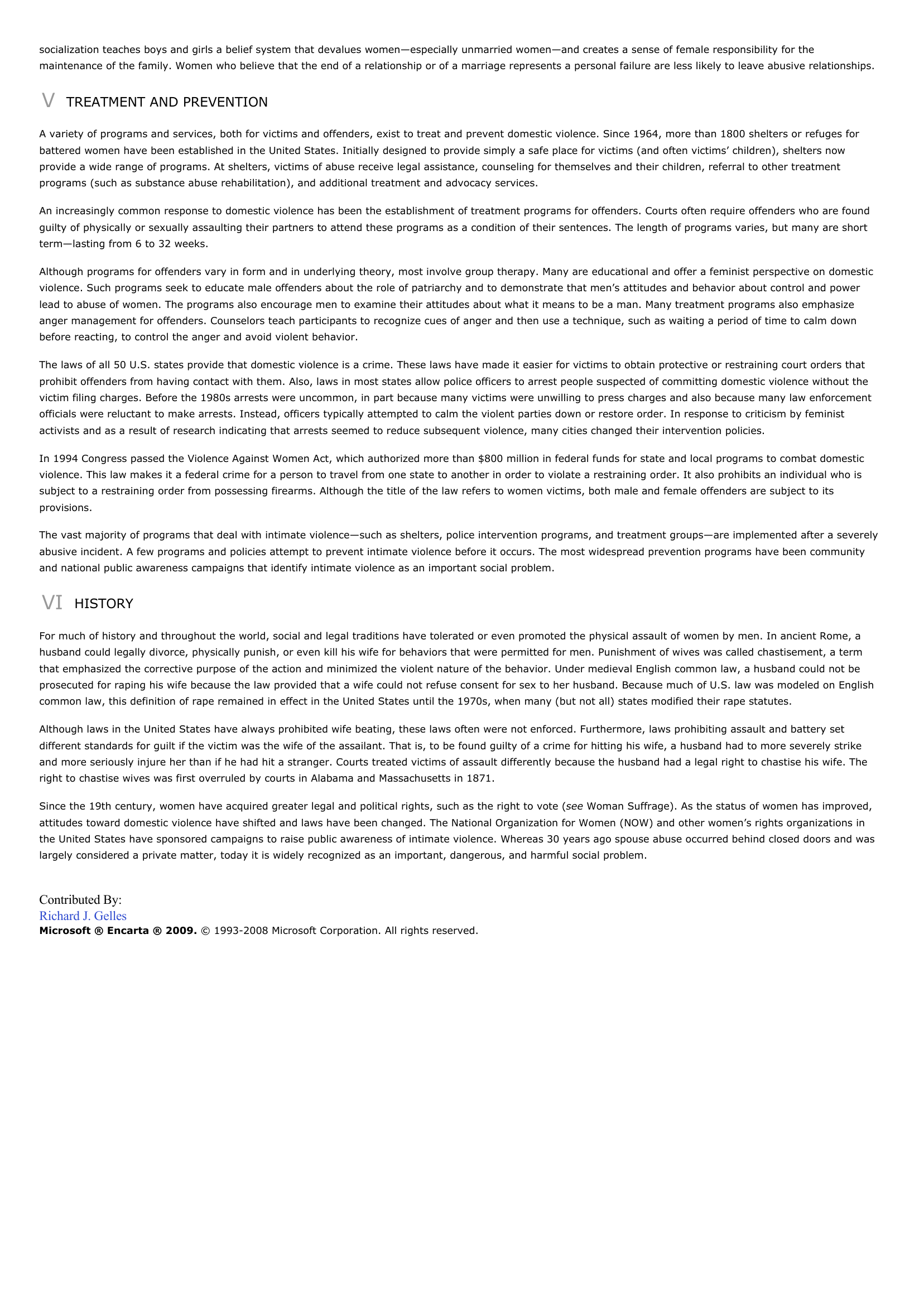Domestic Violence.
Publié le 10/05/2013
Extrait du document
«
socialization teaches boys and girls a belief system that devalues women—especially unmarried women—and creates a sense of female responsibility for themaintenance of the family.
Women who believe that the end of a relationship or of a marriage represents a personal failure are less likely to leave abusive relationships.
V TREATMENT AND PREVENTION
A variety of programs and services, both for victims and offenders, exist to treat and prevent domestic violence.
Since 1964, more than 1800 shelters or refuges forbattered women have been established in the United States.
Initially designed to provide simply a safe place for victims (and often victims’ children), shelters nowprovide a wide range of programs.
At shelters, victims of abuse receive legal assistance, counseling for themselves and their children, referral to other treatmentprograms (such as substance abuse rehabilitation), and additional treatment and advocacy services.
An increasingly common response to domestic violence has been the establishment of treatment programs for offenders.
Courts often require offenders who are foundguilty of physically or sexually assaulting their partners to attend these programs as a condition of their sentences.
The length of programs varies, but many are shortterm—lasting from 6 to 32 weeks.
Although programs for offenders vary in form and in underlying theory, most involve group therapy.
Many are educational and offer a feminist perspective on domesticviolence.
Such programs seek to educate male offenders about the role of patriarchy and to demonstrate that men’s attitudes and behavior about control and powerlead to abuse of women.
The programs also encourage men to examine their attitudes about what it means to be a man.
Many treatment programs also emphasizeanger management for offenders.
Counselors teach participants to recognize cues of anger and then use a technique, such as waiting a period of time to calm downbefore reacting, to control the anger and avoid violent behavior.
The laws of all 50 U.S.
states provide that domestic violence is a crime.
These laws have made it easier for victims to obtain protective or restraining court orders thatprohibit offenders from having contact with them.
Also, laws in most states allow police officers to arrest people suspected of committing domestic violence without thevictim filing charges.
Before the 1980s arrests were uncommon, in part because many victims were unwilling to press charges and also because many law enforcementofficials were reluctant to make arrests.
Instead, officers typically attempted to calm the violent parties down or restore order.
In response to criticism by feministactivists and as a result of research indicating that arrests seemed to reduce subsequent violence, many cities changed their intervention policies.
In 1994 Congress passed the Violence Against Women Act, which authorized more than $800 million in federal funds for state and local programs to combat domesticviolence.
This law makes it a federal crime for a person to travel from one state to another in order to violate a restraining order.
It also prohibits an individual who issubject to a restraining order from possessing firearms.
Although the title of the law refers to women victims, both male and female offenders are subject to itsprovisions.
The vast majority of programs that deal with intimate violence—such as shelters, police intervention programs, and treatment groups—are implemented after a severelyabusive incident.
A few programs and policies attempt to prevent intimate violence before it occurs.
The most widespread prevention programs have been communityand national public awareness campaigns that identify intimate violence as an important social problem.
VI HISTORY
For much of history and throughout the world, social and legal traditions have tolerated or even promoted the physical assault of women by men.
In ancient Rome, ahusband could legally divorce, physically punish, or even kill his wife for behaviors that were permitted for men.
Punishment of wives was called chastisement, a termthat emphasized the corrective purpose of the action and minimized the violent nature of the behavior.
Under medieval English common law, a husband could not beprosecuted for raping his wife because the law provided that a wife could not refuse consent for sex to her husband.
Because much of U.S.
law was modeled on Englishcommon law, this definition of rape remained in effect in the United States until the 1970s, when many (but not all) states modified their rape statutes.
Although laws in the United States have always prohibited wife beating, these laws often were not enforced.
Furthermore, laws prohibiting assault and battery setdifferent standards for guilt if the victim was the wife of the assailant.
That is, to be found guilty of a crime for hitting his wife, a husband had to more severely strikeand more seriously injure her than if he had hit a stranger.
Courts treated victims of assault differently because the husband had a legal right to chastise his wife.
Theright to chastise wives was first overruled by courts in Alabama and Massachusetts in 1871.
Since the 19th century, women have acquired greater legal and political rights, such as the right to vote ( see Woman Suffrage).
As the status of women has improved, attitudes toward domestic violence have shifted and laws have been changed.
The National Organization for Women (NOW) and other women’s rights organizations inthe United States have sponsored campaigns to raise public awareness of intimate violence.
Whereas 30 years ago spouse abuse occurred behind closed doors and waslargely considered a private matter, today it is widely recognized as an important, dangerous, and harmful social problem.
Contributed By:Richard J.
GellesMicrosoft ® Encarta ® 2009. © 1993-2008 Microsoft Corporation.
All rights reserved..
»
↓↓↓ APERÇU DU DOCUMENT ↓↓↓
Liens utiles
- Exposé sur la violence conjugale
- SUJET DE REFLEXION Parler est-ce renoncer à la violence ?
- commentaire LES BONNES - le malaise, la violence et la haine
- La violencia de genero (la violence des genres
- Comment la littérature peut-elle témoigner de la violence de l’histoire ?


